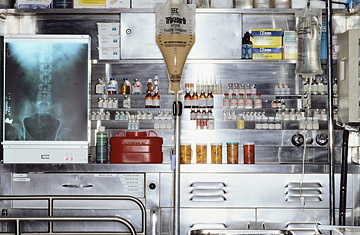
Some industries are obvious energy hogs: airlines, autos, office buildings. Others, like health care, are stealthier consumers. But the U.S. health-care infrastructure is one of the country's hungriest users of energy.
Medical procedures, for instance, rack up massive energy tabs — especially surgeries, emergency services and pathology laboratory tests. "Enormous amounts of energy are required to build and run high-tech systems in common use — MRIs, CT scans, etc. — with many running 24 hours a day," says Pamela Gray, a trustee of the Transition Network, a U.K.-based organization that supports community-level initiatives to improve sustainability and combat climate change. Further, nearly all pharmaceuticals are made from petroleum derivatives, and so are medical materials (think rubber gloves and intravenous tubing). And then there's transportation: transferring equipment, supplies and lab samples, or getting patients to the right facility, sometimes by ambulance or helicopter. (See TIME's A-Z Health Guide.)
Square foot by square foot, hospitals use twice as much energy as office buildings. Health care is the second most energy-intensive industry in the U.S., after food service and sales, with energy costs of $6.5 billion a year — a number that continues to rise. As the nation's 78 million baby boomers age, their need for medical services will dramatically increase. Meanwhile, the steady effects of a warming climate, say epidemiologists, will lead to an increase in infectious and chronic conditions, such as allergies and respiratory disease.
Forward-thinking medical institutions are taking a hard look at their energy portfolio. "I've seen a huge uptick in hospitals exploring and investigating" ways to reduce fossil-fuel dependence, says Nick DeDominicis of Practice Green Health, particularly since 2007 when World Health Organization and U.N. reports suggested that climate change due to fossil-fuel use and CO2 emissions could threaten public health. Hospitals, such as the California-based Kaiser Permanente and San Francisco's Catholic Healthcare West, have gone greener by swapping out old equipment for more energy-efficient systems of heating, cooling, lighting and dehumidifying. DeDominicis says a typical hospital could reduce energy waste 20% to 25%, with corresponding decreases in cost and emissions. (See TIME's special report on the environment.)
Another approach is to rely on alternative energy sources. According to the EPA, hospitals could shift 30% of their energy requirements to renewables, like wind and solar, without sacrificing quality of care. In terms of how they buy energy, "hospitals have a choice," says DeDominicis. "The choice can impact human health — buy it right, impact it right, use it right."
DeDominicis notes that there are contracting mechanisms that allow medical institutions to set up renewable energy projects on-site, without capital investment. There are also energy-purchasing programs like Practice Green Health's "virtual marketplace" model, which involves real-time reverse energy auctions on the Web: instead of buyers competing to purchase energy, sellers auction packages that include renewables. That drives down the price and narrows cost margins, and the savings allow for a higher percentage of alternative fuels in the package. For example, Ingalls Health System, a 563-bed hospital with satellite facilities in south suburban Chicago, bought a plan with 5% green fuels. Ingalls can expect to see a 3,433-ton reduction of CO2 in the first year — plus more than $1.5 million in savings over the course of the three-year contract.
Dan Bednarz of Energy & Healthcare Consultants in Pittsburgh contends that the medical industry needs to rethink how it uses energy and, more important, figure out how it can get by on less — something that will become an inevitability when oil prices start creeping up again. Last summer's high fuel costs gave some in the field an inkling of what hospitals might face. "The old method of 'just in time' delivery for supplies [and trauma patients] made sense with energy sufficiency," says Bednarz. "It makes no sense when you have energy scarcity or very high prices." He says facilities will need to plan ahead, use less fuel to ensure adequate availability and devote warehouse space to stocking up on supplies.
Bednarz's prescription for lower-oil medicine also demands more emphasis on public health and preventive medicine — a focus on wellness rather than illness — which would naturally lower the burden on the health-care system. He adds that physicians can further reduce their dependence on technology — and oil — by better developing their experiential and tactile knowledge, reclaiming a part of medicine's low-tech past. Much of the energy-intensive lab tests and scans doctors routinely prescribe are "redundant, unnecessary," he says. "An important element in care is whether you feel the person caring for you cares for you."
The Transition Network's Gray suggests more localized health-care efforts, including networks of trained medical workers, educational programs teaching nutrition, first-aid and self-care, and expert-patient teaching opportunities. She proposes that by increasing insurance coverage of so-called alternative medicine — including low-energy practices like acupuncture, homeopathy, nutritionists and herbalists — more patients might seek greener care.
The first step, says Bednarz, is to recognize medicine's dependence on oil. Then "human ingenuity and creativity will kick in and we'll get actual solutions for moving medicine beyond oil."
